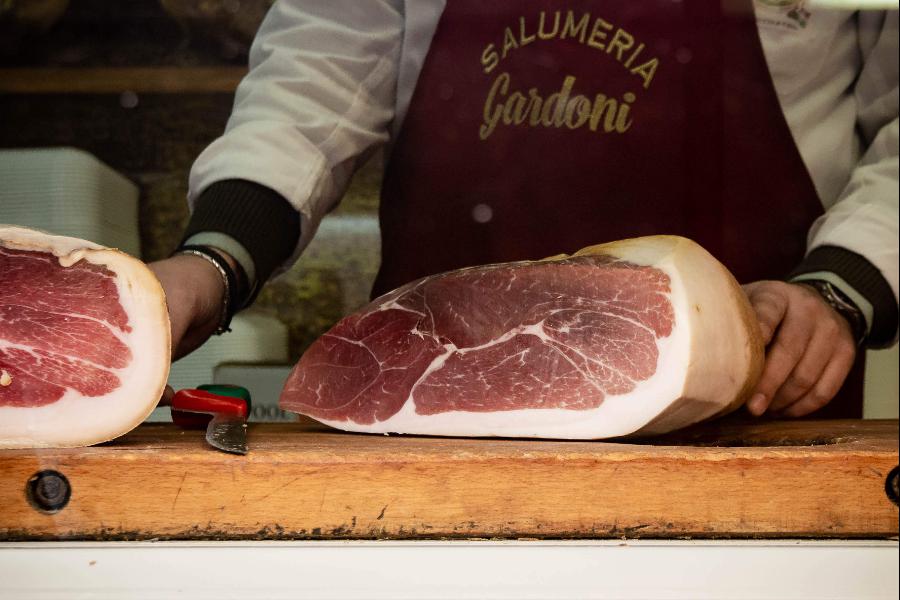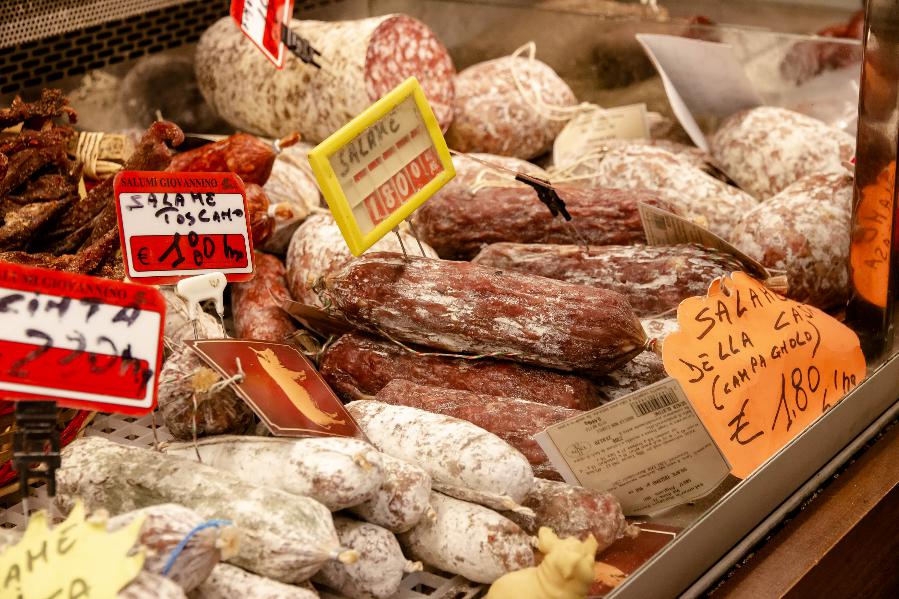Ham and salami look like they belong together on a board, but they’re not the same type of cured meat at all. They’re made differently, aged differently, stored differently, and even sliced differently.
I’ve been curing meat, brining whole pork legs, smoking hams, and hanging salami for decades. After doing it yourself — not just buying it — you stop thinking “ham vs salami is just flavor” and start noticing structure, process, and texture.
Ham is taken from the hind leg of a pig and cured as a whole muscle. It can be salted and aged, brined and cooked, or smoked. Salami is a seasoned ground meat sausage (usually pork, sometimes beef or game) that’s packed into a casing, fermented, and slowly dried — or cooked/smoked to finish.
That single difference — whole muscle vs ground and seasoned — changes everything. That’s why prosciutto doesn’t eat like salami, even though both are technically “cured pork.”

In Part 1, I’ll cover salami in detail — how it’s made, why pH matters, and why properly dried salami is safe to slice and eat without cooking. In Part 2, I’ll break down ham styles, smoking, serving, pairing, and a direct side-by-side comparison.
What Is Salami?
Salami is a cured sausage. The base idea is simple: take meat, add salt and spices, mix in diced fat, stuff it in a casing, and turn it into something that can be stored and eaten later. The way you “finish” it is what creates the different styles of salami people are used to buying and eating.
I’ve made traditional salami using wild venison. With wild game, you need to add pork fat back into the mix or the salami dries out and becomes crumbly. Getting that fat ratio right — usually at least around 20% — is the difference between a slice that eats rich and smooth, and something that tastes like seasoned cardboard.
Traditional vs Commercial Salami Production
Traditional dry-cured salami is the style a lot of people picture when they think “proper Italian salami.” After stuffing the seasoned meat and fat into a casing, the salami is fermented, then slowly dried in controlled humidity and temperature. No cooking step. No fast shortcuts. Just fermentation, time, and moisture loss.
This is why you’ll see whole salamis hanging at room temperature in parts of Europe. Once a salami has dried properly, it doesn’t rely on refrigeration the same way fresh meat does. It’s been preserved through salt, controlled acidity, and water loss.
Commercial / cooked or hot-smoked salami takes a different route. Instead of hanging for a long drying period, some versions are heated or smoked to a cooked internal temperature. Others are pushed acidic very quickly so they’re microbiologically safe without long aging. You still get a “salami,” and it’s still sliceable and ready to eat, but the flavor usually isn’t as layered or slow-developed as a traditional dry cure.

Ingredients and Flavor Profile
Good salami isn’t just “spiced mince.” It’s balanced. Salt is always there. After that you usually see black pepper, garlic, herbs, sometimes wine, sometimes chili, sometimes fennel seed depending on the region. The fat chunks you see in the slice are not just visual — that fat is what melts slightly on the tongue and gives salami that silky bite.
That’s also why lean, fatless salami almost never tastes right. It dries too aggressively and the mouthfeel turns grainy. A proper salami slice should show distinct white fat pieces inside darker cured meat, almost like a mosaic when you look at it from the side.
Fermentation and Drying Process
Once stuffed, salami goes into a warm, short fermentation stage — usually one to three days. That stage is not random. You’re letting certain bacteria wake up and start converting sugars into acid. That shift in acidity drops the pH and helps block out the wrong microbes early on.
After fermentation, the salami moves into a cooler, more humid environment and hangs there to dry slowly. This can run for weeks or even months depending on style and diameter. During this dry, you’re aiming for controlled moisture loss. It’s totally normal for a finished dry-cured salami to lose 35–50% of its starting weight by the end.
That moisture loss is not just texture. It’s part of the preservation. Less available water means fewer places for unwanted bacteria to survive. It’s old-school preservation that still works.
What Does pH Have to Do with Salami?
pH is one of the quiet safety levers when you’re making salami the right way. For fermented, dry-cured salami, you want the pH to land below about 5.3. That level of acidity is considered a safe zone. Unwanted bacteria don’t like it.
At the same time, the “good” microbes and natural enzymes continue their work, and flavor develops in the background as the sausage dries. This is where real salami becomes complex — savory, rich, slightly tangy, sometimes with gentle funk and sweetness — instead of just salty or sour.
When that process is done, the result is fully ready to eat. Traditional dry-cured salami doesn’t need to be cooked before you slice it. It’s already finished. That’s very different from fresh sausage, which is raw and absolutely does need to be cooked. It’s also different from many ham styles, which are either aged whole or cooked/smoked after brining. We’ll get into those next.
What Is Ham?
Ham is made from the hind leg of a pig and cured as a single, whole muscle — not ground like salami. As a result, ham develops a smoother texture and a milder flavor. It can be preserved with salt alone, soaked or injected with brine, or smoked for both flavor and longevity. Each method creates an entirely different result.
Whole Muscle vs Ground Cured Meats
When I work with whole muscles like ham, salt needs to move from the surface deep into the meat fibers. That process takes time. With ground products such as salami, the seasoning is already mixed throughout, so the curing acts uniformly. This is why ham has a cleaner, sometimes sweeter taste, while salami has a deeper tang from fermentation and fat distribution.
Ham’s natural grain gives it a dense, even structure. Each slice shows solid muscle fibers, unlike the speckled mosaic pattern seen inside a salami. Both are cured meats, but they couldn’t be more different in mouthfeel.
What Is Cured Ham?
“Curing” simply means using salt to preserve meat. Depending on the style, hams are cured dry or wet. Dry-curing uses salt and air; wet-curing uses a salt-and-water brine. Once cured, ham is either aged and eaten raw (like prosciutto) or cooked/smoked (like traditional deli ham). Both styles are perfectly safe to eat when finished correctly.
I’ve written before about dry-curing vs wet-brining and how each impacts texture, flavor, and storage. The choice usually comes down to tradition and taste. Dry-curing builds intensity over time; wet-brining offers consistency and tenderness faster.
Dry-Cured Ham (Prosciutto, Jamón, etc.)
Salt and Seasoning Stages
Dry-cured hams rely entirely on salt to extract moisture and create a safe, stable environment for long aging. Some producers add sugar, pepper, garlic, or even local wine to build regional flavor. The salted hams rest for weeks as the cure draws liquid out. Once the salt has penetrated, they’re rinsed and moved into a cool, ventilated area to begin drying.
The slow transformation that follows is what makes prosciutto or jamón so incredible. Over time, enzymes break down muscle fibers, creating tenderness and aroma that can’t be rushed. I’ve watched prosciutto legs mature for two years in Parma — and the air inside the cellar smells sweet, nutty, and unmistakably cured.
Drying and Aging Duration
Depending on the environment, a dry-cured ham might hang from 9 months to 36 months. The longer it hangs, the more complex it becomes. I’ve seen butchers wipe the outer surface with pork fat to slow drying and preserve the inner moisture balance — a classic technique in Italy and Spain. Once aging is complete, the ham is sliced paper-thin and served uncooked.

If you’ve ever wondered how to keep salt levels balanced, my guide on how to cure ham so it’s not salty explains the ratios and timing. Proper salt-to-weight measurement is everything in this stage.
Wet-Cured Ham (Brined and Cooked)
Brine Composition (Salt, Sugar, Spices)
Wet-curing is more common in commercial ham production. The ham is submerged or injected with brine made from water, salt, sugar, and sometimes spices. This keeps the meat juicy and gives it a mild, slightly sweet taste. The process is faster than dry-curing, which is why it’s used for the hams most people find in supermarkets.
The USDA provides detailed information on the safety and preparation of cooked and smoked hams. You can read their official guidance here: USDA ham and food safety.
Smoking and Cooking Steps
Once brined, the ham is cooked or smoked until it reaches the proper internal temperature. I’ve smoked hams in offset smokers, gas grills, and even a converted wine barrel — all that matters is keeping a clean, steady smoke. Too much heat or unclean smoke can make the exterior tough and bitter. A gentle, smoldering fire produces a sweeter, more balanced flavor.

What Is Smoked Ham?
Smoked ham can begin as either a dry or wet cure. What matters most is the smoke. Cold smoking adds flavor without cooking; hot smoking both cooks and cures. I often use fruitwood like apple or cherry for a subtle sweetness. Smoke also adds natural antioxidants that help extend the ham’s life and deepen its flavor profile.
Ham vs Salami Comparison at a Glance
| Aspect | Ham | Salami |
|---|---|---|
| Meat Type | Whole leg muscle (pork) | Ground mixture (pork, beef, or game) |
| Preparation | Dry-cured, brined, or smoked | Fermented and dried, or cooked/smoked |
| Texture | Smooth, single muscle fibers | Firm, marbled with visible fat |
| Storage | Dry-cured: shelf-stable; wet-cured: refrigerated | Dry-cured: shelf-stable; cooked: refrigerated |
| Edibility | Dry-cured and cooked are ready to eat | All salami types are ready to eat once cured |
Ham and Salami on a Charcuterie Board
Pairing with Cheese and Wine
Dry-cured hams like prosciutto pair beautifully with mild, creamy cheeses and sweet fruit. Salami, being bolder and spicier, works best with aged cheeses and something acidic like pickles or mustard. For more inspiration, check out this guide on pairing cured meats and cheeses.
Serving Temperature and Presentation
Always serve both at room temperature. Cold fat dulls flavor and texture. Give the slices 20–30 minutes on the counter before serving. I like folding ham into ribbons and layering salami diagonally so the marbling catches the light. It’s not just presentation — it helps the flavors breathe.
FAQ
Is salami raw or cooked?
Traditional dry-cured salami isn’t cooked, but it’s safe and ready to eat. The combination of salt, fermentation, and drying makes it shelf-stable. Some modern salamis are cooked or hot-smoked to reach a finished temperature faster.
Do I need to cook ham from the store?
Most ham from the store is fully cured and cooked or smoked, so it’s ready to eat cold. Dry-cured hams like prosciutto or jamón are aged raw, salted, and sliced paper-thin — no cooking required.
Which lasts longer, ham or salami?
Properly dry-cured salami generally lasts longer because of its lower moisture. Dry-cured hams also keep well for months, but brined or cooked hams need refrigeration and should be eaten within a week.
If you’re building a board or curing at home, which do you prefer — the sweet saltiness of ham or the rich tang of salami? Let me know in the comments below; I love hearing what others are crafting or serving.

Tom Mueller
For decades, immersed in studying, working, learning, and teaching the craft of meat curing, sharing the passion and showcasing the world of charcuterie and smoked meat. Read More
